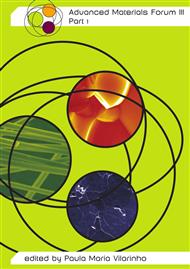p.170
p.175
p.179
p.184
p.188
p.193
p.198
p.202
p.207
Effect of Lead Content and B-Site Substitutions on Dielectric and Piezoelectric Properties of PZT Ceramics
Abstract:
The behaviour of the dielectric and piezoelectric properties of doped PZT ceramics, with variable lead content, has been investigated from –50oC to room temperature. The PZT materials were prepared by the oxide technique and samples were sintered as pellets, at various temperatures. Niobium and lithium ions have been substituted for Ti4+, Zr4+ in the PZT matrix, and a small amount of Bi2O3 was added to cause A-position vacancies. The lead content in the four materials prepared varies in a narrow range, from 0.97 to 1.029 lead atoms, while the concentration of all other components are maintained constant. The microstructure of samples, evaluated by SEM technique and XRD analysis evidenced the presence of the tetragonal phase characteristic for the PZT 52/48. The dielectric and piezoelectric c onstants measured on poled samples depends on the sintering temperature, defects and domain walls, lead content.
Info:
Periodical:
Pages:
188-192
Citation:
Online since:
May 2006
Authors:
Keywords:
Price:
Сopyright:
© 2006 Trans Tech Publications Ltd. All Rights Reserved
Share:
Citation:


